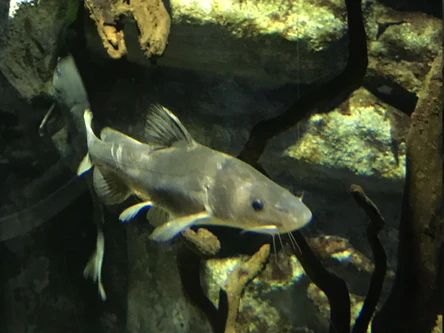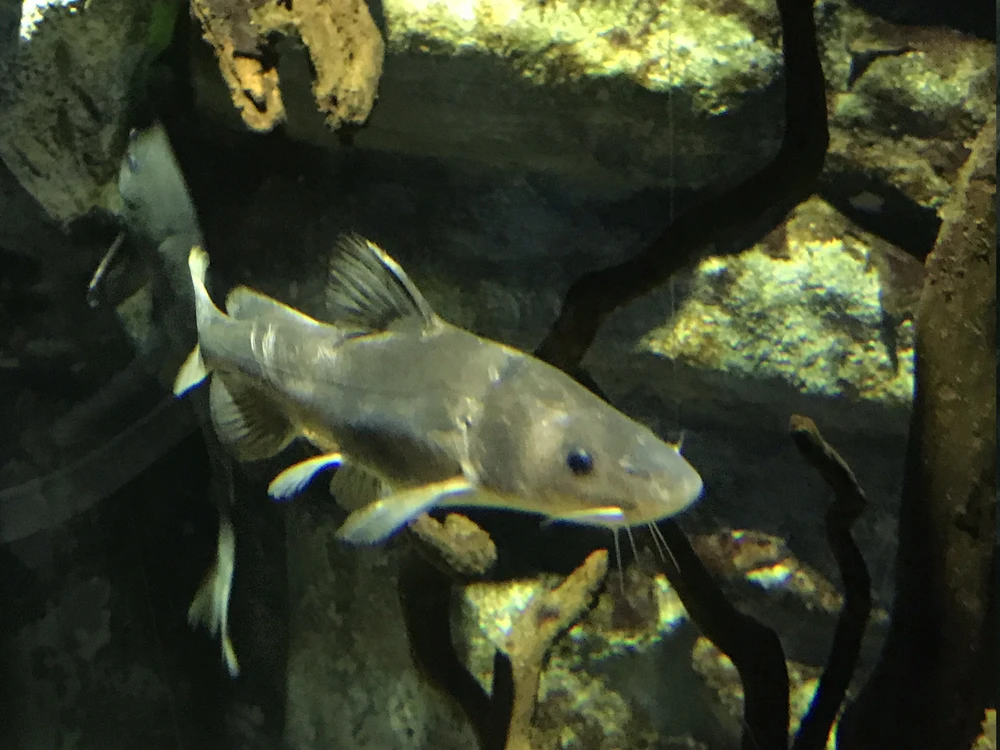Information
Version: B | 1.2 (2024-12-31)
- minor editorial changes plus new side note "Commercial relevance"
WelfareScore | farm
Condensed assessment of the species' likelihood and potential for good fish welfare in aquaculture, based on ethological findings for 10 crucial criteria.
- Li = Likelihood that the individuals of the species experience good welfare under minimal farming conditions
- Po = Potential of the individuals of the species to experience good welfare under high-standard farming conditions
- Ce = Certainty of our findings in Likelihood and Potential
WelfareScore = Sum of criteria scoring "High" (max. 10)
General remarks
Tachysurus dumerili is a demersal and nocturnal catfish species that lives in rivers of eastern China and western Korea. Culture of T. dumerili became popular in China due to its high market value and a rapid declining of the natural population, affected by overfishing, environmental pollution, and habitat fragmentation. Efforts have been put in researching nutritional parameters and genetics of T. dumerili.
However, there is a reported lack of data on broodstock management, captive breeding, and larval rearing techniques. Additionally, there is a lack of English literature on T. dumerili's natural habitat and behaviour in the wild. T. dumerili is very aggressive while in captivity and has been reported to be stressed by handling, which are unfavourable welfare parameters for cultivated species. The most probable slaughter technique used for T. dumerili is ice slurry. Therefore, an alternative high-standard slaughter method needs to be researched for this species.
1 Home range
Many species traverse in a limited horizontal space (even if just for a certain period of time per year); the home range may be described as a species' understanding of its environment (i.e., its cognitive map) for the most important resources it needs access to.
What is the probability of providing the species' whole home range in captivity?
It is unclear for minimal and high-standard farming conditions. Our conclusion is based on a low amount of evidence.


2 Depth range
Given the availability of resources (food, shelter) or the need to avoid predators, species spend their time within a certain depth range.
What is the probability of providing the species' whole depth range in captivity?
It is unclear for minimal and high-standard farming conditions. Our conclusion is based on a low amount of evidence.


3 Migration
Some species undergo seasonal changes of environments for different purposes (feeding, spawning, etc.), and to move there, they migrate for more or less extensive distances.
What is the probability of providing farming conditions that are compatible with the migrating or habitat-changing behaviour of the species?
It is unclear for minimal and high-standard farming conditions. Our conclusion is based on a low amount of evidence.


4 Reproduction
A species reproduces at a certain age, season, and sex ratio and possibly involving courtship rituals.
What is the probability of the species reproducing naturally in captivity without manipulation of these circumstances?
It is unclear for minimal and high-standard farming conditions. Our conclusion is based on a low amount of evidence.


5 Aggregation
Species differ in the way they co-exist with conspecifics or other species from being solitary to aggregating unstructured, casually roaming in shoals or closely coordinating in schools of varying densities.
What is the probability of providing farming conditions that are compatible with the aggregation behaviour of the species?
It is unclear for minimal and high-standard farming conditions. Our conclusion is based on a low amount of evidence.


6 Aggression
There is a range of adverse reactions in species, spanning from being relatively indifferent towards others to defending valuable resources (e.g., food, territory, mates) to actively attacking opponents.
What is the probability of the species being non-aggressive and non-territorial in captivity?
It is low for minimal and high-standard farming conditions. Our conclusion is based on a low amount of evidence.


7 Substrate
Depending on where in the water column the species lives, it differs in interacting with or relying on various substrates for feeding or covering purposes (e.g., plants, rocks and stones, sand and mud, turbidity).
What is the probability of providing the species' substrate and shelter needs in captivity?
It is low for minimal farming conditions. It is medium for high-standard farming conditions. Our conclusion is based on a medium amount of evidence.


8 Stress
Farming involves subjecting the species to diverse procedures (e.g., handling, air exposure, short-term confinement, short-term crowding, transport), sudden parameter changes or repeated disturbances (e.g., husbandry, size-grading).
What is the probability of the species not being stressed?
It is low for minimal and high-standard farming conditions. Our conclusion is based on a low amount of evidence.


9 Malformations
Deformities that – in contrast to diseases – are commonly irreversible may indicate sub-optimal rearing conditions (e.g., mechanical stress during hatching and rearing, environmental factors unless mentioned in crit. 3, aquatic pollutants, nutritional deficiencies) or a general incompatibility of the species with being farmed.
What is the probability of the species being malformed rarely?
It is unclear for minimal and high-standard farming conditions. Our conclusion is based on a low amount of evidence.


10 Slaughter
The cornerstone for a humane treatment is that slaughter a) immediately follows stunning (i.e., while the individual is unconscious), b) happens according to a clear and reproducible set of instructions verified under farming conditions, and c) avoids pain, suffering, and distress.
What is the probability of the species being slaughtered according to a humane slaughter protocol?
It is low for minimal farming conditions. It is medium for high-standard farming conditions. Our conclusion is based on a low amount of evidence.


Side note: Domestication
Teletchea and Fontaine introduced 5 domestication levels illustrating how far species are from having their life cycle closed in captivity without wild input, how long they have been reared in captivity, and whether breeding programmes are in place.
What is the species’ domestication level?
DOMESTICATION LEVEL 333, level 5 being fully domesticated.
Side note: Forage fish in the feed
450-1,000 milliard wild-caught fishes end up being processed into fish meal and fish oil each year which contributes to overfishing and represents enormous suffering. There is a broad range of feeding types within species reared in captivity.
To what degree may fish meal and fish oil based on forage fish be replaced by non-forage fishery components (e.g., poultry blood meal) or sustainable sources (e.g., soybean cake)?
All age classes: WILD: piscivorous 16281423, insectivorous 1423, crustaceans 161423, molluscs 14, over 40 types of preys 16. FARM: fish meal may be not replaced 2 and fish oil may be completely* replaced by sustainable sources 34, but no data found yet for ADULTS and SPAWNERS.
partly = <51% – mostly = 51-99% – completely = 100%
Side note: Commercial relevance
How much is this species farmed annually?
21,610 t in 2018 35.
Glossary
BENTHIC = living at the bottom of a body of water, able to rest on the floor
DEMERSAL = living and feeding on or near the bottom of a body of water, mostly benthopelagic, some benthic
DOMESTICATION LEVEL 3 = entire life cycle closed in captivity with wild inputs 33
FARM = setting in farming environment or under conditions simulating farming environment in terms of size of facility or number of individuals
FRY = larvae from external feeding on
IND = individuals
JUVENILES = fully developed but immature individuals
LAB = setting in laboratory environment
LARVAE = hatching to mouth opening
PHOTOPERIOD = duration of daylight
POTAMODROMOUS = migrating within fresh water
SPAWNERS = adults during the spawning season; in farms: adults that are kept as broodstock
WILD = setting in the wild
Bibliography
2 Xie, Shouqi, Xiqin He, and Yunxia Yang. 1998. Effects on growth and feed utilization of Chinese longsnout catfish Leiocassis longirostris Günther of replacement of dietary fishmeal by soybean cake. Aquaculture Nutrition 4: 187–192. https://doi.org/10.1046/j.1365-2095.1998.00069.x.
3 De Silva, Sena S. 2001. Reservoir and culture-based fisheries: biology and management : proceedings of an international workshop held in Bangkok, Thailand, from 15-18 February 2000. Canberra, ACT: Australian Centre for International Agricultural Research.
4 Huang, Geng, Qidong Wang, Ting Yuan, Mantang Xiong, Jiashou Liu, Zhongjie Li, and Sena S. De Silva. 2020. Combined effects of fish cage culture and increased fishing pressure on wild fish assemblages in a large reservoir, Yangtze River basin, China. Aquaculture 526: 735373. https://doi.org/10.1016/j.aquaculture.2020.735373.
5 Wang, Fei, Xuzhou Ma, Wu Wang, and Jiyuan Liu. 2012. Comparison of proximate composition, amino acid and fatty acid profiles in wild, pond- and cage-cultured longsnout catfish (Leiocassis longirostris): Comparison of wild and cultured longsnout catfish. International Journal of Food Science & Technology 47: 1772–1776. https://doi.org/10.1111/j.1365-2621.2012.03033.x.
6 Cai, Shuang-Hu, Zao-He Wu, Ji-Chang Jian, Yi-Shan Lu, and Ju-Feng Tang. 2012. Characterization of pathogenic Aeromonas veronii bv. veronii associated with ulcerative syndrome from Chinese longsnout catfish (Leiocassis longirostris Günther). Brazilian Journal of Microbiology 43: 382–388. https://doi.org/10.1590/S1517-83822012000100046.
7 Li, M., Xu-Zhou Ma, and Wu Wang. 2012. Effects of aquatic macrophyte Pistia stratiotes L. on growth and nitrogen and phosphorus budgets in Leiocassis longirostris reared in net cages. Journal of Dalian Ocean University 27: 402–406.
8 Wang, QiJie, Li Meng, Ma XuZhou, Lei JunYi, Wang Wu, Gao JianZhong, and Li XingXing. 2015. Effects of combination of two aquatic plants on purification of water nitrogen and phosphorus pollutants of Lieocassis longiristris culture in net cage. Journal of Shanghai Ocean University 24: 227–234.
9 Wang, QiJie, Li Meng, Ma XuZhou, Wang Wu, Gao JianZhong, and Li XingXing. 2016. Effects of planting Pistia stratiotes L. and Azolla imbircata (Roxb.) Nakai on emission of nitrogen and phosphorus from Lieocassis longiristris culture in net cage. Acta Agriculturae Shanghai 32: 110–115.
10 Pei, Z., S. Xie, W. Lei, X. Zhu, and Y. Yang. 2004. Comparative study on the effect of dietary lipid level on growth and feed utilization for gibel carp (Carassius auratus gibelio) and Chinese longsnout catfish (Leiocassis longirostris Günther). Aquaculture Nutrition 10: 209–216. https://doi.org/10.1111/j.1365-2095.2004.00291.x.
11 Liu, Haiyan, Shouqi Xie, Xiaoming Zhu, Wu Lei, Dong Han, and Yunxia Yang. 2008. Effects of dietary ascorbic acid supplementation on the growth performance, immune and stress response in juvenile Leiocassis longirostris Günther exposed to ammonia. Aquaculture Research 39: 1628–1638. https://doi.org/10.1111/j.1365-2109.2008.02036.x.
12 Han, Dong, Shouqi Xie, Wu Lei, Xiaoming Zhu, and Yunxia Yang. 2004. Effect of ration on the growth and energy budget of Chinese longsnout catfish, Leiocassis longirostris Günther. Aquaculture Research 35: 866–873. https://doi.org/10.1111/j.1365-2109.2004.01078.x.
13 Han, Dong, Shouqi Xie, Wu Lei, Xiaoming Zhu, and Yunxia Yang. 2005. Effect of light intensity on growth, survival and skin color of juvenile Chinese longsnout catfish (Leiocassis longirostris Günther). Aquaculture 248. Fish Nutrition and Feeding: 299–306. https://doi.org/10.1016/j.aquaculture.2005.03.016.
14 Baidu. 2022. 长吻鮠. 百度百科.
15 Lin Xiaozhi, Li Dongmei, Liu Huanzhang, Lin Hongsheng, Yang Shaorong, Fan Hanjin, Wen Rushu, et al. 2016. Fish species diversity and its seasonal variations in the Chaozhou section of Hanjiang River, Guangdong Province. Biodiversity Science 24: 185–194. https://doi.org/10.17520/biods.2015188.
16 Wu, Q. J. 1975. Study on population ecology and maximum continuable yields of Chinese longsnout catfish (Leiocassis longirostris Gunther). Acta Hydrobiol. Sin 5: 387–405.
17 Wang, Zhongwei, Jianfeng Zhou, Yuzhen Ye, Qiwei Wei, and Qingjiang Wu. 2006. Genetic Structure and Low-genetic Diversity Suggesting the Necessity for Conservation of the Chinese Longsnout Catfish, Leiocassis longirostris (Pisces: Bagriidae). Environmental Biology of Fishes 75: 455–463. https://doi.org/10.1007/s10641-006-0035-z.
18 Xiao, Ming Song, Hai Wu Xia, and Yu Han Ma. 2012. Genetic variation of the Chinese longsnout catfish Leiocassis longirostris in the Yangtze River revealed using mitochondrial DNA cytochrome b sequences. Acta Ecologica Sinica 32: 305–313. https://doi.org/10.1016/j.chnaes.2012.09.002.
19 Zhu, Xiaoming, Shouqi Xie, Zhongju Zou, Wu Lei, Yibo Cui, Yunxia Yang, and R. J. Wootton. 2004. Compensatory growth and food consumption in gibel carp, Carassius auratus gibelio, and Chinese longsnout catfish, Leiocassis longirostris, experiencing cycles of feed deprivation and re-feeding. Aquaculture 241: 235–247. https://doi.org/10.1016/j.aquaculture.2004.07.027.
20 Dong, X.l., W. Lei, X.m. Zhu, D. Han, Y.x. Yang, and S.q. Xie. 2011. Effects of dietary oxidized fish oil on growth performance and skin colour of Chinese longsnout catfish (Leiocassis longirostris Günther). Aquaculture Nutrition 17: e861–e868. https://doi.org/10.1111/j.1365-2095.2011.00854.x.
21 Wikipedia. 2022. 长吻鮠. 维基百科,自由的百科全书.
22 Yao-guang, Zhang, L. U. O. Quan-shen, and H. E. Xue-fu. 1994. Studies on The Development and Annual Change in The Ovary and The Breeding Habits of A Freshwater Catfish (Leiocassis longirostris). Zoological Research 15: 42–48.
23 PlanetCatfish. 2020. Tachysurus dumerili • Bagridae • Cat-eLog. PlanetCatfish.
24 Li, Xinhui, and Yuguo Xia. 2018. Enhancing Aquaculture Through Artificial Propagation: Freshwater Fish Fry and Fingerling Production. In Aquaculture in China, ed. Jian-Fang Gui, Qisheng Tang, Zhongjie Li, Jiashou Liu, and Sena S. De Silva, 527–539. Chichester, UK: John Wiley & Sons Ltd. https://doi.org/10.1002/9781119120759.ch6_4.
25 Jiwyam, Wirat. 2015. Recent advances in aquaculture of Asian catfishes: an overview. In Carp and catfishes, ed. Bradley Regan, 67–134. Nova Science Publishers, Inc.
26 Wang, L. 1989. Review of reservoir fisheries in China. Reservoir Fisheries 4: 2–7.
27 Cabrera-Álvarez, Maria J. 2022. Personal communication.
28 Wang, Xiaodong, Shu Li, Megan Price, Yi Lei, Bo Wu, Kan Liu, and Zhaobin Song. 2019. Longitudinal and seasonal patterns of fish assemblage structure in the Zhougong River, Sichuan Province, southwest China. Ecological Indicators 107: 105656. https://doi.org/10.1016/j.ecolind.2019.105656.
29 Tan, Q., S. Xie, X. Zhu, W. Lei, and Y. Yang. 2007. Effect of dietary carbohydrate-to-lipid ratios on growth and feed utilization in Chinese longsnout catfish (Leiocassis longirostris Günther). Journal of Applied Ichthyology 23: 605–610. https://doi.org/10.1111/j.1439-0426.2007.00846.x.
30 Lambooij, E, R J Kloosterboer, C Pieterse, M A Gerritzen, and J W Van de vis. 2003. Stunning of farmed African catfish (Clarias gariepinus) using a captive needle pistol; assessment of welfare aspects. Aquaculture Research 34: 1353–1358. https://doi.org/10.1046/j.1365-2109.2003.00966.x.
31 Sattari, A., E. Lambooij, H. Sharifi, W. Abbink, H. Reimert, and J. W. van de Vis. 2010. Industrial dry electro-stunning followed by chilling and decapitation as a slaughter method in Claresse® (Heteroclarias sp.) and African catfish (Clarias gariepinus). Aquaculture 302: 100–105. https://doi.org/10.1016/j.aquaculture.2010.01.011.
32 Lambooij, E., R. J. Kloosterboer, M. A. Gerritzen, and J. W. van de Vis. 2006. Assessment of electrical stunning in fresh water of African Catfish (Clarias gariepinus) and chilling in ice water for loss of consciousness and sensibility. Aquaculture 254: 388–395. https://doi.org/10.1016/j.aquaculture.2005.10.027.
33 Teletchea, Fabrice, and Pascal Fontaine. 2012. Levels of domestication in fish: implications for the sustainable future of aquaculture. Fish and Fisheries 15: 181–195. https://doi.org/10.1111/faf.12006.
34 Choi, Jin, and Lee, Sang-Min. 2015. Effect of Dietary Lipid Sources on Body Fatty Acid Composition of Chinese Longsnout Catfish Leiocassis longirostris. Fisheries and aquatic sciences 18: 359–365. https://doi.org/10.5657/FAS.2015.0359.
35 FAO. 2020. FAO Fisheries and Aquaculture Department - Yearbook of Fishery and Aquaculture Statistics 2018 - Aquaculture production.







